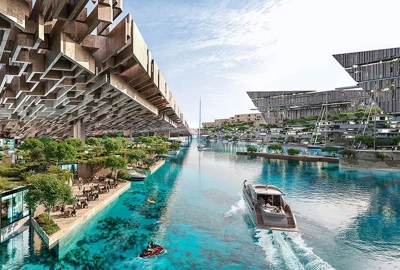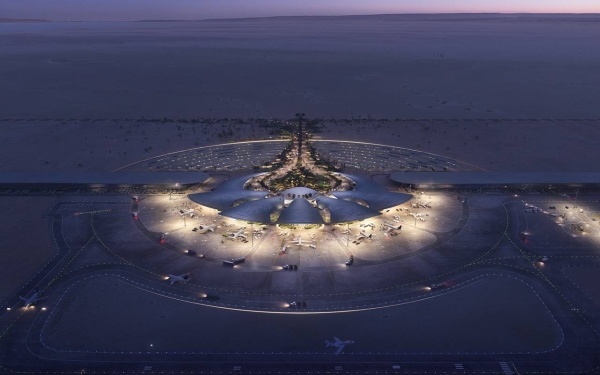

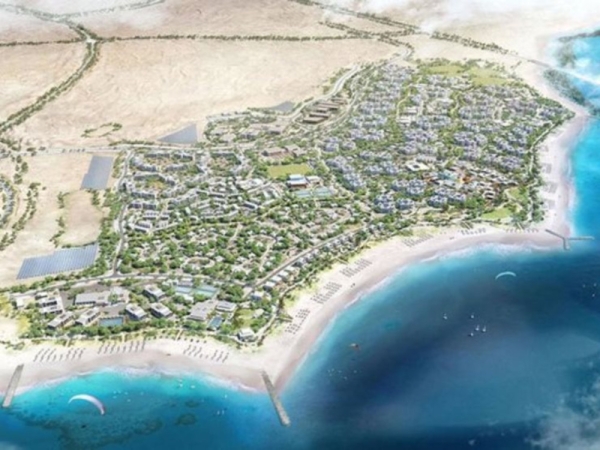
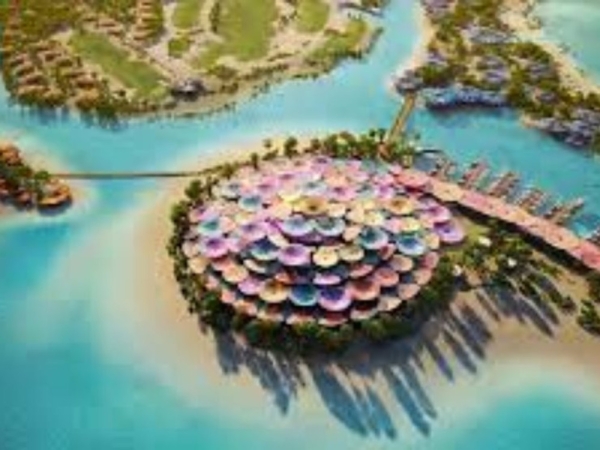
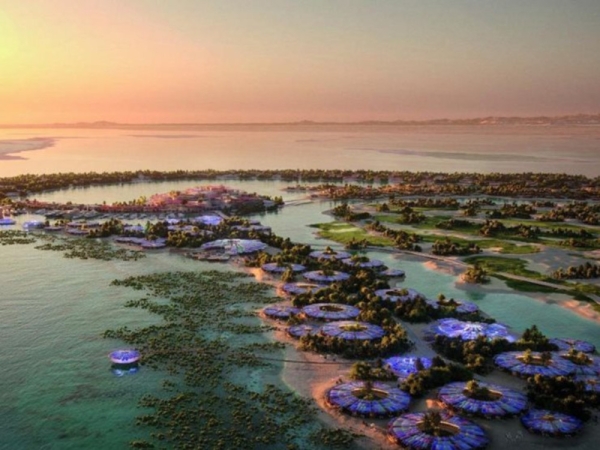
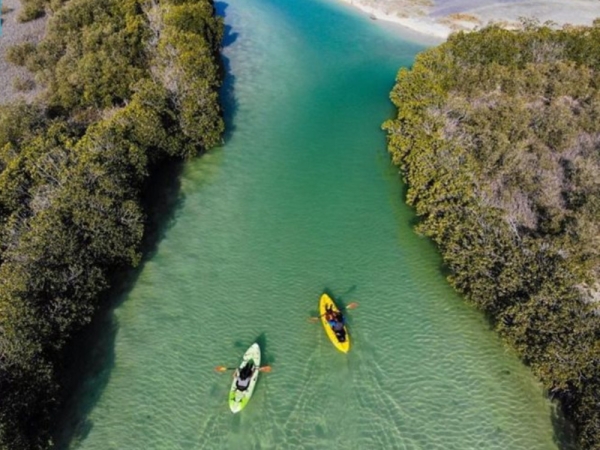
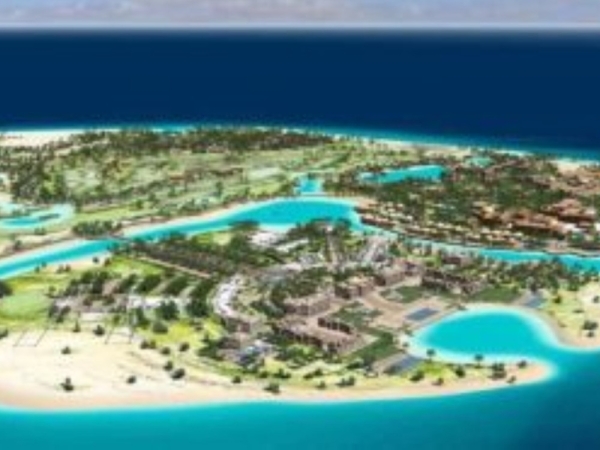
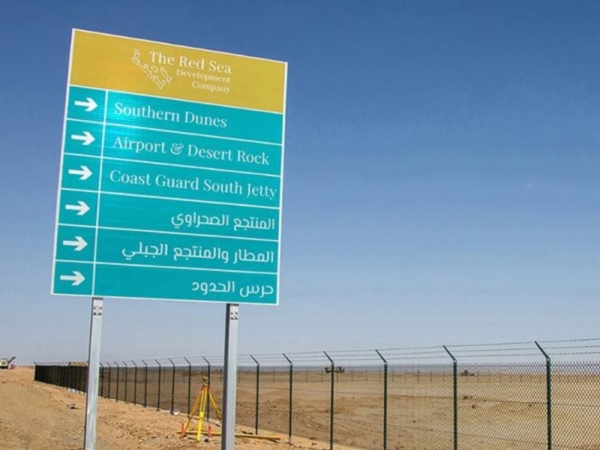
The Red Sea Project is a Saudi tourism project and coastal destination encompassing several pristine islands, with a total area of approximately twenty-eight thousand km². It extends two hundred km along the Red Sea coast on the northwestern side of the Kingdom, between the cities of Umluj and al-Wajh. Once completed, the project will contribute to enhancing Saudi Arabia's presence on the global tourism scene, doubling the Kingdom's economic gains by attracting international tourism companies, direct investments, and channeling Saudi tourism expenditures domestically. The project will be built on ninety pristine islands, with nine islands designated as sites of significant environmental value to preserve the life cycle of the endangered wildlife inhabiting the area. The Red Sea Global Company (developer of the Red Sea and Amaala projects) is implementing a set of environmental policies to ensure that the destination is free of waste and plastic debris, prohibits discharge into the sea, and achieves 100 percent carbon neutrality, relying entirely on renewable energy.
The beginning of establishing the Red Sea project
The Red Sea Project goals
The Red Sea Project is an important part of "Saudi Vision 2030" strategy. It aims to create investment opportunities for the private sector, develop the kingdom's tourism sector by building world-class resorts attractive to both domestic and international tourists, attract leading global names in tourism and hospitality to leverage their expertise, capacities, and financial investments, help young people realize their potential through new economic and cultural opportunities, provide up to seventy thousand new job opportunities, and contribute to boosting Saudi Arabia's economy through new sectors, with an expected addition of SAR22 billion to the gross domestic product (GDP). Additionally, it aims to protect the environment and preserve the kingdom's cultural and civilizational heritage.
The launch of the Red Sea Project
Crown Prince, Chairman of the Council of Ministers, and Chairman of the Public Investment Fund, His Royal Highness Prince Mohammed Bin Salman Bin Abdulaziz Al Saud, announced the launch of the Red Sea Project on July 31, 2017. The foundation stone was laid in the third quarter of 2019, and the first phase was completed in the fourth quarter of 2022. This phase focused on preparing the infrastructure and foundations for the project, as well as developing hotels, residences, airports, ports, and transportation services such as boats and seaplanes. The ownership of the project belongs to the Public Investment Fund, which works on injecting initial investments and attracting new investments to the Kingdom through partnerships with major international companies.
The entity responsible for the Red Sea project
The Red Sea Development Company (now Red Sea Globa) was established in May 2018. It is an independent company responsible for developing the project, fully owned by the Public Investment Fund. John Pagano is its CEO. The company is registered with the Ministry of Commerce as a closed joint-stock company. The company is working on establishing new standards for sustainable development and adopting a set of environmental systems that lead to following best practices by preventing waste dumping, reducing carbon dioxide emissions, and relying on renewable
The Red Sea Project phases
According to the approved master plan, the Red Sea destination will be developed on twenty-two islands out of a total of ninety islands, in two main phases. The first phase began in 2017, during which over eight hundred contracts were signed with a total value exceeding SAR20 billion. The first phase includes the construction of sixteen luxury hotels, totaling three thousand rooms, spread across five islands, in addition to two resorts in the mountain and desert areas to accommodate three hundred thousand visitors. It also includes commercial, entertainment, and retail facilities, as well as other infrastructure amenities, yacht marinas, and an airport for the destination.
The second phase began in 2023 and is expected to be completed by 2030. It will provide eight thousand hotel rooms distributed across twenty-two islands, comprising fifty hotels and six resorts in desert and mountainous areas. Additionally, there will be over one thousand residential properties on the twenty-two islands, along with marinas, golf courses, and various entertainment and recreational facilities. Currently, there are already over fifteen thousand workers at the destination site.
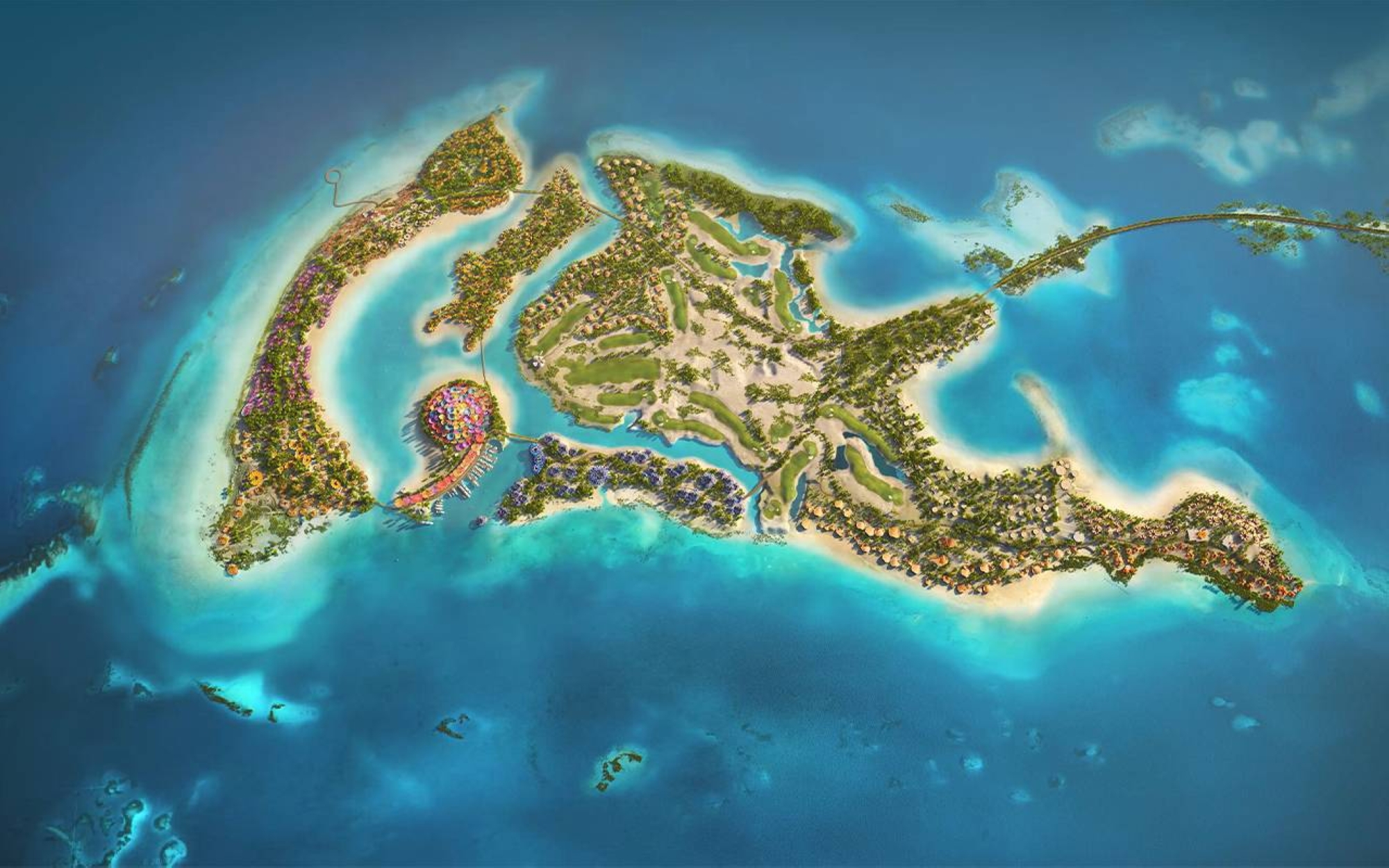
Geographical importance of the Red Sea destination
The natural geographical location
The Red Sea Project is located in the northwestern part of the Kingdom, between latitudes twenty-five and twenty-six north of the equator, approximately five hundred km north of the city of Jeddah. It is bordered to the north by the city of al-Wajh and surrounded by the governorate of Umluj to the south.
The sky over the Red Sea Project is characterized by clarity, facilitating astronomical observation. The winds in the project area generally blow in a northwesterly direction, and the climate is characterized by moderation. The average temperatures annually reach 19.7 degrees Celsius in January and 31.1 degrees Celsius in August, with rainfall occurring during the winter season. The area includes several harrats, mountains, and coral reefs.
Geo-economic location
The Red Sea serves as a link between the Indian Ocean and the Pacific Ocean, and it's considered one of the ancient trade routes between the East and the West, acting as a gateway to the ports of the Kingdom. The project boasts a strategic location at the heart of the world, making it easily accessible to 250 million people. Residents of Western European countries can reach it by air within seven hours, while those in East Asian countries can reach it within eight hours. Access is visa-free for foreigners, in line with the project's specific regulations and laws.
Coastal geomorphological phenomena
The Red Sea is characterized by coastal geomorphological features such as reefs, marinas, bays, peninsulas, and valleys. The surface water temperature in the northwestern regions of the Kingdom ranges from sixteen to twenty-six degrees Celsius throughout the year, while the water masses in the deeper areas, which reach up to 2635 m, remain relatively stable.
The natural environment of the Red Sea project
Harrats, volcanoes, and mountains
The surface features in the Red Sea Project area vary, including low coastal plains estimated to be about three hundred m above sea level, as well as high mountain peaks such as "Mount Umluj", reaching an elevation of 2580 m, and "Mount Shad", reaching an elevation of 2350 m. There are also dormant volcanic craters, like Harrat al-Shaqah and Harrat ar-Raha, out of a total of nineteen, which are considered safe and have shown no signs of volcanic activity or gas emissions. These craters are monogenetic, meaning they occurred once in a specific location and time period, originating in the second stage around five million years ago, with the opening of the Red Sea The project aims to preserve natural resources and invest in developing volcanic and dormant harrats.
Fisheries
The Red Sea is home to over 1350 species of ornamental fish, many of which can be found in the cities of al-Wajh and Umluj. These include butterflyfish, chromis, orchid dottybacks, triggerfish, parrotfish, surgeonfish, groupers, and gobies. They also stand out for their production of fresh fish, most of which inhabit the coral reefs. Economically important fish are also abundant, including red snapper, emperor fish, sherif, kashar, grouper, parrotfish, surgeonfish, barracuda, whitefish, Arabian angelfish, herring, rabbitfish, and lobster.
Seabirds
The area of the Red Sea Project located in the northwest of the Kingdom includes many seabirds, such as the white-cheeked tern and the crowned tern. Some of the islands in the Red Sea host species of rare resident birds (Endemic) found within a specific geographical range and not present in other province, such as the white-eyed gull and other species like the red-billed tropicbird, the brown noddy, the sooty gull, and the greater crested tern. The nesting seabirds, which are summer migratory birds, arrive at the islands in May and June to lay eggs in July of each year. After their chicks reach flying age, they depart at the end of September to reach distant areas, such as Bali Island in Indonesia during January. The organization "BirdLife International" has released a report stating that the Red Sea contains important areas for seabird nesting, which could serve as a tourist attraction for the project area. Fishermen have historically used seabirds during their fishing expeditions as a means to locate fish in the Red Sea, utilizing them as a tool or vital indicator to gauge changes in marine environments. Seabirds feed on small fish, which in turn feed on smaller organisms such as plankton, algae, and marine plants. Therefore, they play a crucial role in the marine ecosystem and have been placed by scientists on the food chain hierarchy in marine environments.
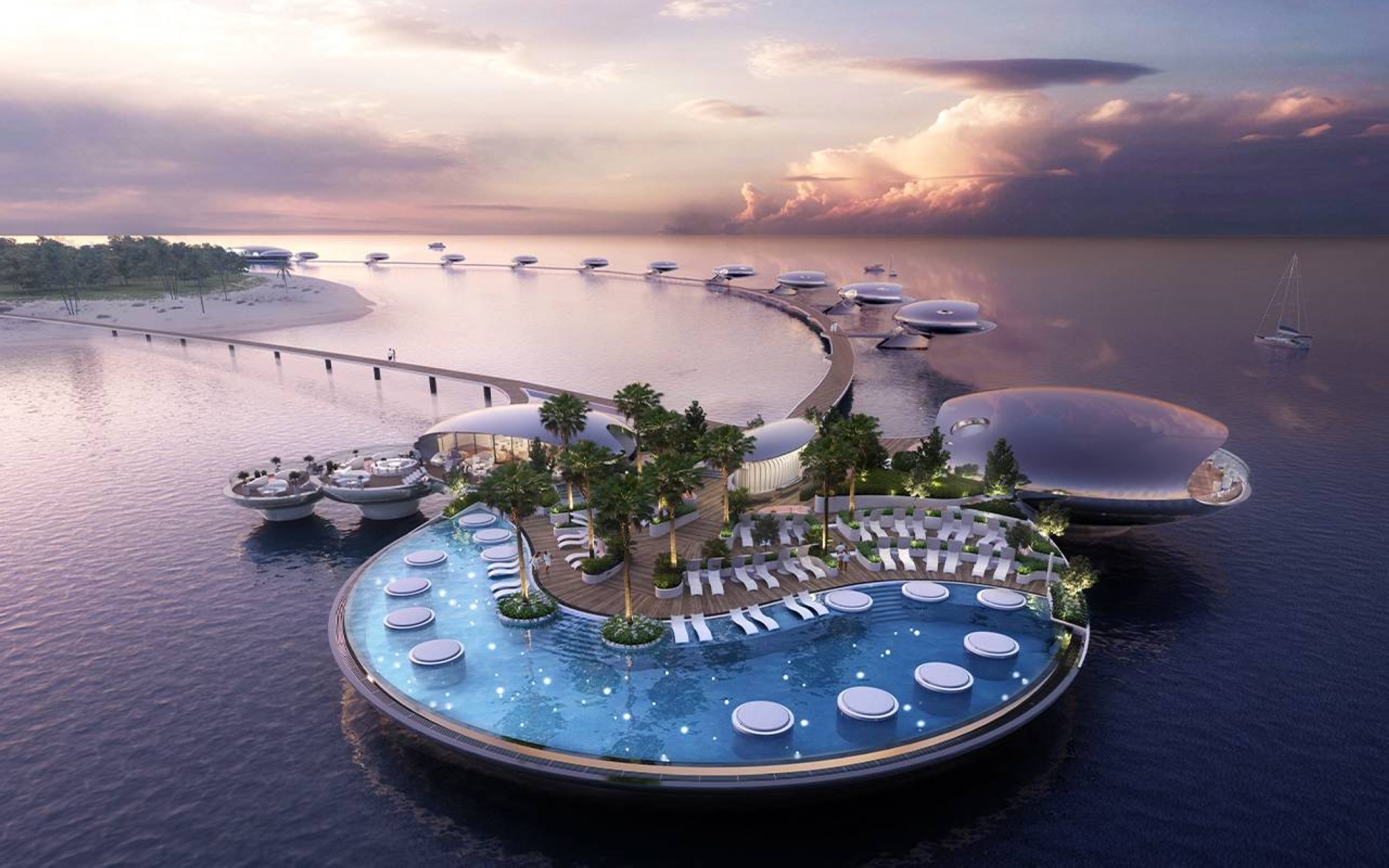
Red Sea project islands
Ummahat Island
Ummahat alshaikh Island is rich in coral reefs, white sandy beaches, and clear waters. When the master plan for the island hotels was developed, one of its tasks was to stay away from coral reef areas, while ensuring smooth access to the hotels and other surrounding facilities.
Ummahat alshaikh Island comprises two resorts: the "St. Regis Red Sea Resort," which includes a water sports center offering various activities such as sailing, surfing, and kayaking along the coral reef, as well as international floating restaurants and wellness facilities. And the "Nujoom, Ritz-Carlton Reserve Resort." Visitors can learn scuba diving and engage in unique underwater experiences by participating in diving lessons offered by the modern diving center, as well as going on exploratory trips into the depths of the sea.
Shura "Shurayrah" Island
Shurayrah Island is one of the ninety islands and is home to a diverse marine life of coral reefs. It is located in the Tabuk province, northwest of the Kingdom, at the intersection of latitude 25°30'00" North and longitude 36°57'12" East. It covers an area of approximately 5.6 km² and is about 0.90 nautical miles away from the coast. It is an island that resembles a dolphin in its natural formation. It is considered a main interface for the Red Sea Project, and is home to many wild animals and plants. The island is connected to the mainland by a causeway that is approximately 3.3 km long. It includes a bridge that is 1.2 km long and features two small gaps, each thirty-six mwide at the ends of the causeway, to provide space for marine mammals to move freely. This bridge serves as the primary means of access for guests to reach the island.
The island hosts around eleven hotels managed by international hospitality brands such as "EDITION Hotels," "Fairmont Hotels & Resorts," "Raffles Hotels & Resorts," "SLS Hotels & Residences," "InterContinental Hotels & Resorts," "Jumeirah Group," MiraVal, Rosewood, and "Grand Hayatt." The island features tourist attractions and landmarks, including an eighteen-hole golf course prepared to host international tournaments, a marina, a beach club, as well as a diverse array of retail options. The resorts are characterized by a shared architectural design, constructed using lightweight materials with low thermal mass. The buildings are designed to naturally protect themselves from corrosion while creating new habitats in the same location to enhance the island's natural environment.
Sheybarah Island
It is one of the islands located in the Red Sea, furthest from the mainland, situated southeast of the Red Sea Development Company archipelago in the Red Sea. It falls under the Tabuk province in the northwest of Saudi Arabia, at the intersection of latitude 34°24'25" north and longitude 00°53'36" east. It covers an area of approximately 19.8 km² and includes a coral reef measuring between thirty-forty m in length. It is about 8.40 nautical miles from the coast and a forty-five-minute boat ride from the main shore, making it suitable for diving enthusiasts. The island hosts seventy-three hotel units, ranging from residential to overwater villas. The weight of the overwater villa is approximately 150 t, with a circular design inspired by sand dunes. Its interior design is crafted from stainless steel with high reflectivity.
Red Sea International Airport
Opening of the Red Sea Project Airport
The Red Sea Airport is an international airport dedicated to serving the Red Sea Project, with a capacity of accommodating one million tourists annually through domestic and international flights by 2030, with a maximum of nine hundred passengers per hour. Five weekly flights are operated through the Red Sea International Airport by Saudi Arabian Airlines, with three flights weekly from Riyadh via King Khalid International Airport and two flights weekly from Jeddah City via King Abdulaziz International Airport.
Cooperation between the Red Sea Company and Saudi Arabian Airlines
The Red Sea Global Company signed a memorandum of understanding with the General Authority of Civil Aviation to achieve the goals of Saudi Vision 2030 regarding the tourism sector, support the Red Sea Project, market it as a global tourist destination, enhance commercial flights to the destination, encourage joint participation in local and international exhibitions, and launch joint international marketing campaigns. During its participation in an exhibition hosted by the General Authority for Tourism and National Heritage (currently the Ministry of Tourism) in Riyadh, the Red Sea International Company launched the electronic tourist visa, which allows citizens of forty-nine countries to visit and explore the Kingdom. Saudi Arabian Airlines also transported employees of the Red Sea Project on its inaugural flight to the destination.
Renewable energy at Red Sea International Airport
In line with the sustainability goals of the Red Sea Company, the Red Sea Project Airport was designed by the global engineering consultancy firm "Foster Partners", led by world-class architects. The airport achieves carbon neutrality and operates entirely on 100 percent renewable energy. It also achieves zero emissions through environmentally friendly and sustainable operational mechanisms, with designs inspired by the Saudi Arabian landscape. The airport also includes shaded areas and areas with natural ventilation, to help reduce the use of air conditioning.
The infrastructure for air navigation
Red Sea Development Company (Red Sea Global) signed a contract with a consortium composed of two Saudi companies, "Nesma and Partners Contracting Company Limited, and Public Buildings Company" for the development of the infrastructure for air navigation at the Red Sea International Airport. The project includes the development and design of the main runway F, which is approximately 3700 m long, as well as runway B designated for seaplanes. Additionally, it involves the construction of helipads, main and connecting taxiways, pavement works, and the provision of necessary navigational assistance for aviation, including ground lighting for the runway.
Smart technology in the Red Sea project
"Timelapse" technology
The Red Sea Global Company has signed a contract with "EarthCam" to document the construction phases of the project across thirteen sites, including both land-based and marine locations surrounding the Red Sea Project destination. This is facilitated through a high-quality photographic system utilizing time-lapse technology known as "Time Lapse", involving participation from investors and operators. This high-quality technology records the developmental stages of the destination, airport, resorts in the mountain and desert areas, employee city, labor village, islands undergoing development in the first phase of the project, as well as the bridge connecting the mainland to Shura Island "Shurayrah" and its remote monitoring. Monthly images and video footage are updated every thirty minutes and accessible through personal computers and smartphones.
Enablon system
During the global COVID-19 pandemic, the Red Sea Global Company launched a project to deploy Enablon system units in January 2021. This initiative aimed to address environmental, health, and safety challenges, as well as automate initial operations used by the Health and Safety Department. On April 18, 2022, the company announced the successful completion of the first phase of the project, following the stages of design and consultation. The project aims to integrate governance practices, risk compliance, health and safety, environmental sustainability, business continuity, and internal auditing within the company's departments to enhance reporting processes, monitor and align various functions to establish best health and safety practices, and set new standards in the sector. The workforce on-site has exceeded sixteen thousand, including employees of the Red Sea Development Company and its contractors. The Enablon system works without the need for an Internet connection, as it allows the preparation of accident data or inspection and audit reports, and then downloading them when the device is connected to the network. All Red Sea Company contractors and a number of the health and safety team were trained on the system, under the supervision of system engineers.
Internet of Things technology
The Red Sea Global Company signed a contract with the local IoT services company, "MachinesTalk", to establish and deploy a "LoRaWAN "network across the project area. They launched an IoT platform and provided smart identification badges for over 36,000 construction workers operating within an area of over 3,500 km². Additionally, wireless smart cards were deployed to track three thousand vehicles operating on-site, controlling access to construction sites and tracking fleet movement across four main aspects of the construction and development zone: site security, worker safety, mobility control, and construction operation efficiency. Unauthorized access to project areas was prevented, as entry permits were granted based on specific criteria, and alerts were sent for any related violations.
To ensure timely task execution, the technology predicts the arrival time of vehicles at the site, remotely identifies their location, defines boundaries and geographic locations, and activates alerts for idle workers or delayed vehicles. Additionally, it triggers emergency alerts allowing workers to report any emergencies directly to the Red Sea Company's emergency response and security center. This ensures the immediate dispatch of response teams to the worker's location for rescue operations. Remote real-time tracking, based on work maps, worker locations, and temperature measurement and location devices, will allow for more efficient utilization of project resources.
The technology is applied to all contractors working on the Red Sea Development Company project to verify their presence on-site and allow them to register their vehicles and workers. It also monitors the wireless identification badges and smart cards of the workers through the temperatures recorded on-site to ensure their proper device usage, change of devices with low battery, and provide remote disabling capabilities in cases of loss or misuse.
Community contributions to the Red Sea Project
Brains for Brine Challenge
In an attempt to address environmental challenges, the Red Sea Development Company, in collaboration with King Abdullah University of Science and Technology (KAUST), launched an international innovation competition in 2019. The competition aimed to challenge scientists, academics, engineers, and the water industry sector to come up with innovative solutions for disposing of brine residue resulting from water desalination. The competition was supervised and evaluated by experts from the Water Desalination and Reuse Center at King Abdullah University of Science and Technology.
The "Brains for Brine" competition received around 125 submissions from all over the world. After a comprehensive evaluation process conducted by experts, five participants were selected to present their ideas at the "Aquatech Amsterdam" exhibition. Three winning entries were chosen, and the winners received a cash prize of approximately USD10,000 each, along with the opportunity to implement their ideas with the support of the Red Sea Development Company.
Elite Graduate Program
It is a program for recent graduates based on the principle of on-the-job training through rotational assignments in various departments. The aim is to train Saudi youth, refine their talents, and prepare them for work in new career paths provided by the Red Sea Project, gained from global experts. The program lasts for two years and includes pathways such as operations, institutional performance, project management, finance and investment, governance and risk management, environment and sustainability, education and development, project delivery, health, safety and environmental security, procurement and supply management, and development management. The Red Sea Global Company announced the program on November 28, 2019, with the first edition launching in 2020. Several conditions were set for joining the program, including being a Saudi national, recent graduate, committed to the program full-time, holding a bachelor's or master's degree accredited by the Saudi Ministry of Education, and proficiency in both spoken and written English and Arabic.
Sustainability Stewards
It's one of the initiatives of the Red Sea Global Company aimed at providing training programs for members of the local community. It aims to enhance their awareness of the importance of conserving the natural life in the destination, leading current and future initiatives, planning and implementing them, and engaging Saudis in global competition by providing them with skills, knowledge, and experiences. It is an extension of an old system called "al-Hima," which was prevalent in the Arabian Peninsula and ensured achieving integrated balance between the environment of the population and their natural resources.
The Sustainablility Stewards work on promoting and disseminating environmental behavior among all sectors of the local community surrounding the project. They expand the knowledge of new employees about the types of plant and animal species in the region by showcasing a variety of plants in the area. They also educate on achieving environmental balance for the destination and conserving biodiversity through workshops and providing information.
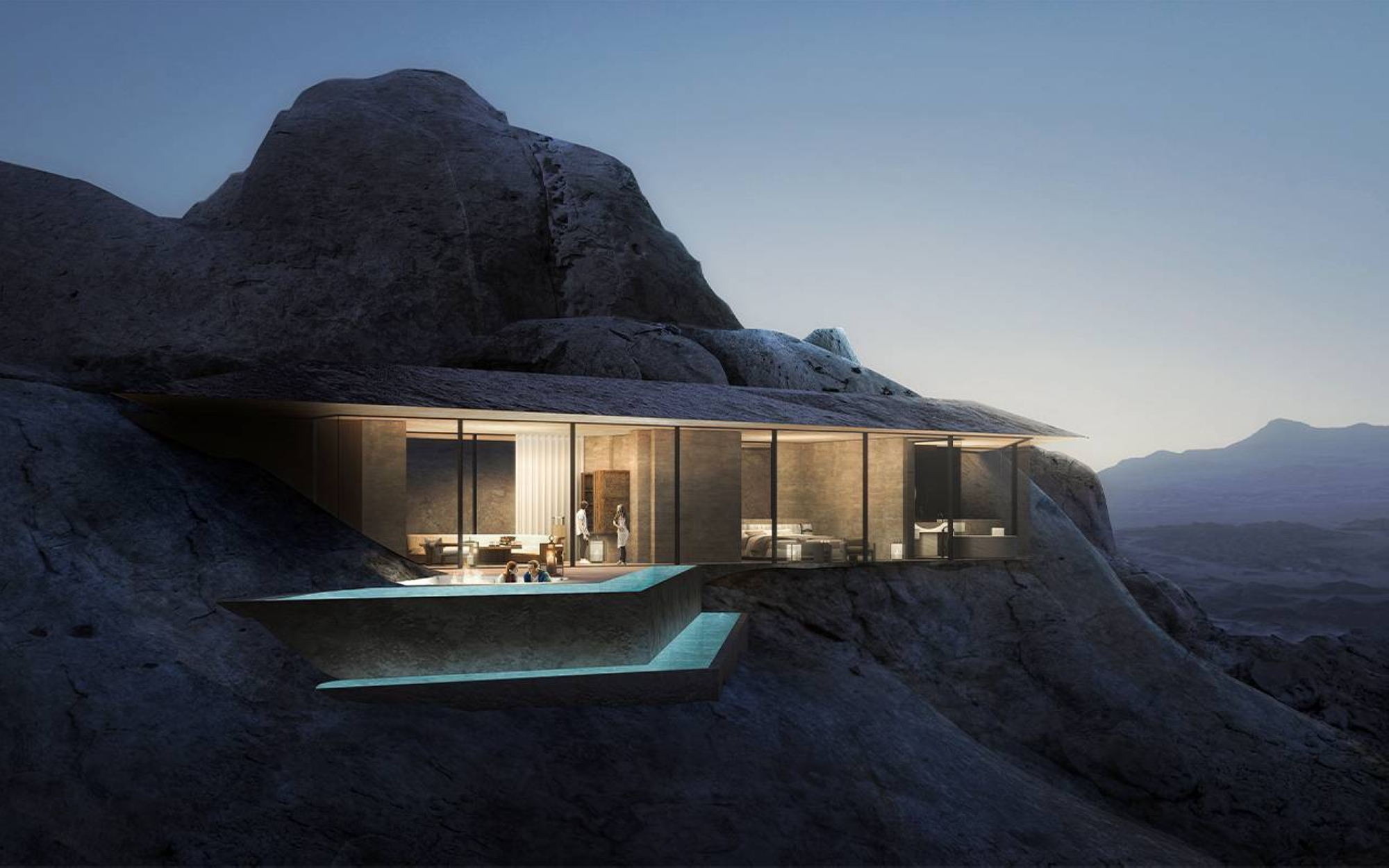
Sustainability in the Red Sea project
The Marine Debris Clean-up Program
In conjunction with the "International Coastal Cleanup Campaign" organized by "Ocean Conservancy," Red Sea Global launched the "The Marine Debris Clean-up Program in the Red Sea Project" to become a partner in the United Nations initiative for "Achieving Sustainable Development Goals." The program will support two of the Sustainable Development Goals: Life Below Water and Life on Land, and it expands to support other goals, including responsible consumption and production, sustainable cities and communities, decent work and economic growth, poverty eradication, and quality education.
The "The Marine Debris Clean-up Program in the Red Sea Project" is an extensive project that includes continuous monitoring of environmental health and periodic participation in cleaning up any debris on the islands and beaches of the project area and disposing of them. It also involves collaboration with academic institutions in various educational projects, such as King Abdullah University of Science and Technology and Tabuk University, and raising awareness among residents of the areas near the project about the harm caused by various types of waste and environmentally safe disposal methods.
Red Sea Ecotecture
The Red Sea Corporate Company launched a competition for the best sustainable and "eco-friendly" architectural design for the community center within the residential district in the coastal village. The competition aims to nurture young talents by engaging students from architecture and design colleges in Saudi universities (both public and private), as well as recent graduates, in the process of innovative design. It encourages them to participate with their projects, witness their designs come to life if selected and awarded, and contribute to the development of a global tourist destination. Additionally, it aims to enhance the hospitality and eco-tourism sectors while preserving the architectural and urban character of the project.
The community center is located at the heart of the coastal village and provides a variety of services to the employees of the Red Sea Global Company and their families, as well as other workforce members within the destination. The center features a public library, childcare facilities, a gymnasium, and a mosque. Meanwhile, the "coastal village" includes administrative offices, residential units, and commercial facilities to serve the company's staff and the rest of the workforce at the project site. At the end of 2022, the first phase of the project was inaugurated, hosting approximately fourteen thousand employees working at the destination. Housing was built for twenty-five thousand employees involved in infrastructure development and assets of the destination.
The selected designs are chosen based on creativity in space utilization, adherence to architectural and engineering concepts that align with sustainability principles, integration of sustainable smart technological solutions, maturity of designs, and compatibility with environmental considerations at the destination. Judgement is rendered by a judging committee comprised of a team of experts encompassing design, construction, and development fields.
Green Concrete application
In pursuit of environmental sustainability, the Red Sea Global collaborated with "Al Falah Ready Mix" to provide low-carbon green concrete, which consists of structures that offer environmentally low-impact resource provision. Additionally, it collaborated with "Saudi Amana Contracting" for the delivery of pre-finished modular units.
Carbon-negative concrete manufacturing
On the sidelines of the United Nations Climate Change Conference COP27 in Egypt, the Red Sea Global signed a memorandum of understanding with the global company "Partanna," specializing in manufacturing the world's first carbon-negative concrete. Concrete is characterized by its strength and versatility, like traditional cement.
Carbon-negative concrete technology works by not emitting any carbon emissions, absorbing carbon from the atmosphere, and generating carbon that can be sequestered. Its use in desalination brine as a key element brings special benefits to the Middle East, where desalination plants can yield more freshwater per treated liter and supply the remainder to "Partanna".
Tourism in The Red Sea Project
Coral Bloom
HRH Prince Mohammed Bin Salman Bin Abdulaziz launched the design vision for "Coral Bloom" in 2021. It serves as the main gateway for the Red Sea Project's "Shurayrah Island," designed by the British company "Foster Partners". "Coral Bloom" refers to the flourishing of coral, featuring sustainable designs inspired by native plants and animals in the Kingdom.
The design vision revolves around biodiversity, focusing on the protection and preservation of mangrove trees and other habitats. They serve as a frontline defense against erosion and exposure, while also developing new habitats through coordinated gardens and creating a new lake and beaches on the island. Coral Bloom will represent approximately 80 percent of the developed hotels during the first phase, comprising eleven resorts and hotels managed by a group of global hospitality brands. The hotel features expansive spaces without internal corridors to align with travelers' preferences, especially after the "COVID-19" pandemic. It consists of a single floor designed in the shape of floating timber. To achieve high energy efficiency and minimize environmental impact, Coral Bloom was constructed using lightweight building materials with low thermal mass and minimal environmental impact, manufactured outside the province.
The golf area also includes residential villas, a large golf club with expansive views of the island's coast, and a golf course designed with components that align with sustainability standards. Additionally, there's a study on maintenance methods and environmental care to minimize impact. It features vast green spaces, eighteen world-class holes, and is equipped to host international tournaments.
Landscape Nursery
"Red Sea Global" has announced the awarding of a joint contract to "Nesma Holding" and "Professional Landscape" to design and construct a plant nursery spanning one million m² (one hundred ha) within the Red Sea project site. This nursery will contribute to cultivating the project's vegetation cover by producing and providing fifteen million seedlings. These seedlings will consist of various locally cultivated plants adapted to the prevailing climatic conditions in the province, as well as different desert plants imported from external environments. Ensuring their suitability for the project's natural conditions is a priority. Additionally, water consumption will be minimized through controlled irrigation practices, including water purification methods such as sewage treatment and recycling for irrigation purposes.
Vocational Training Program
In collaboration with the Housing Association for Family Development in Umluj and the University of Tabuk, approximately forty-five trainees graduated from the Vocational Training Program, and have begun working initially at the agricultural nursery owned by Umluj Municipality. Among them, five employees were selected to participate as supervisors in a three-week additional training program, while the remaining trainees, selected under the "Horticulture" specialization, underwent a six-week training program. They were then enrolled in a theoretical training program lasting 144 hours at the University of Tabuk in Umluj. This program aimed to enhance their English language conversation skills and familiarize them with horticultural and agricultural terminology.
Astrotourism
The Red Sea Global signed a contract with "Kendall", a multi-disciplinary engineering consulting firm, to develop a strategy aimed at reducing nighttime lighting operations at the Red Sea destination. The collaboration aims to provide innovative solutions in the field of sustainable engineering design. The Red Sea Global aims to obtain accreditation from the International Dark-Sky Association (IDA) for several of its natural areas, joining over one hundred global sites accredited by the Dark Sky Association. This endeavor is supported by its local communities and its commitment to strict measures.
The company "Kendall" is working with the engineering and development teams at The Red Sea Global to review the project plan and advise on measures to reduce light pollution. This includes engaging with the local community in the area to raise awareness about appropriate actions they can take to support the initiative. This involves encouraging the use of low-cost, energy-efficient outdoor lighting solutions.
To submit an official application for international accreditation for dark sky reserves in the destination, the team is working on adopting the baseline status as a future reference point. This involves surveying the current lighting equipment and installation details across all destination assets, including general area lighting on buildings, park illumination, streetlights, and landmarks. They are following a plan to identify necessary improvement works at all destination locations and selecting lighting designs for new assets such as hotels, airports, and residential units.
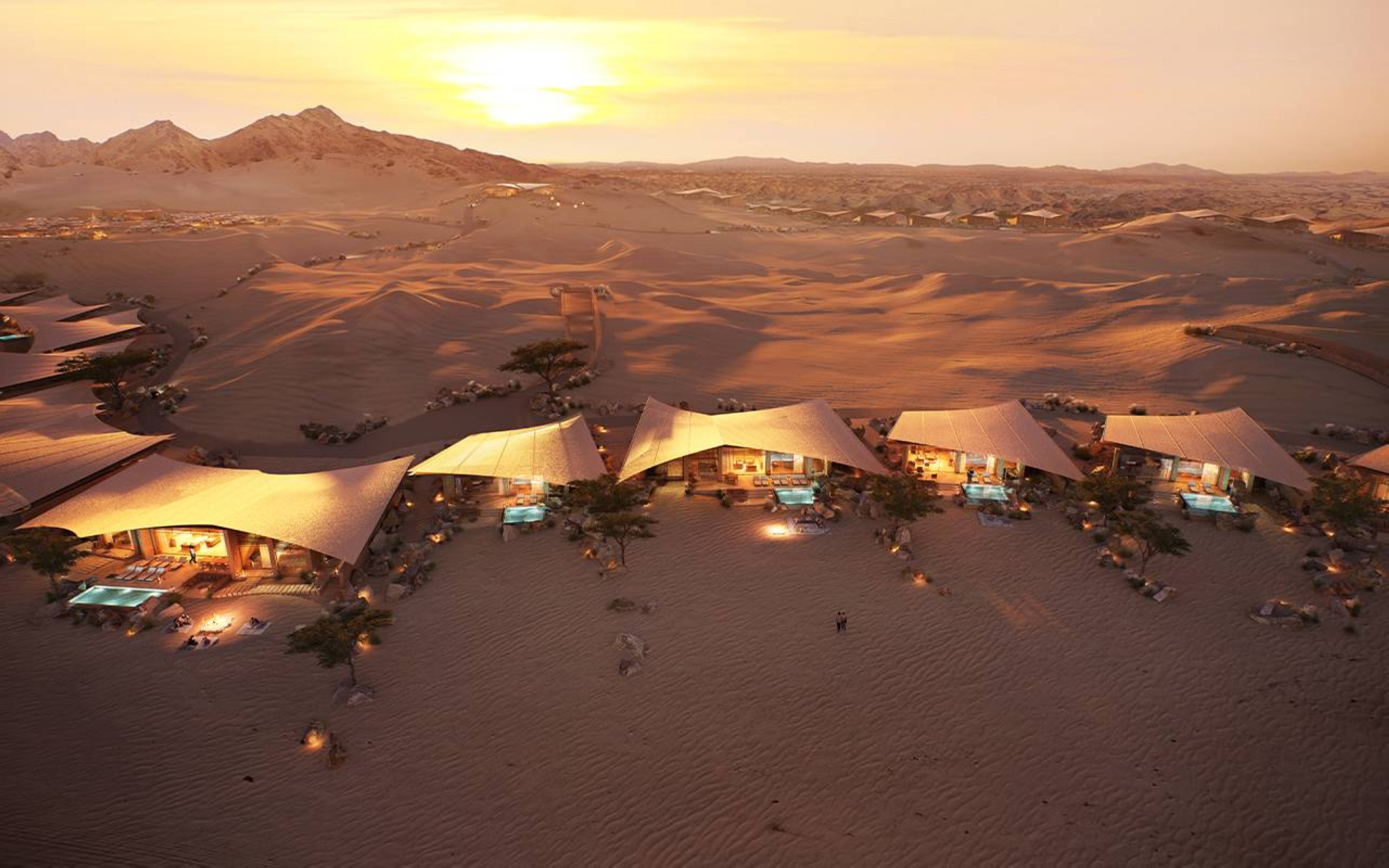
Mountain tourism
"Desert Rock" Resort
Construction works began at the "Desert Rock" Resort in July 2021. It is located in one of the valleys within the project area on the western coast of the Kingdom.
The global firm Oppenheim Architecture designed the mountain resort "Desert Rock" in a way that preserves and enhances the environment, allowing guests to interact directly with the nature and culture of the local area at the same time.
Visitors' transit route to the resort will be through a natural valley hidden between the mountains. The resort, built inside the mountain, offers forty-eight villas and twelve hotel suites, totaling sixty keys, with fully integrated architectural designs blending with the mountain rocks to preserve its scenic beauty. The "Desert Rock" mountain resort offers a variety of luxurious accommodation units, including ground-level rooms, hotel suites built into the middle of the mountain, and a limited number of hotel rooms carved into the mountain rock. Additionally, the resort features a world-class spa, fitness center, secluded dining areas, and a distinctive lake oasis.
The road network leading to the resort has been carved along the edges of the main valley to be concealed behind the existing natural landscapes, thereby reducing both noise and light pollution. Visitors can take long walks and enjoy tourist trips aboard vehicles designated for sand dunes exploration while stargazing as part of the many tourist activities available to visitors at the destination site.
The resort is designed in a way that helps reduce energy consumption, implement water conservation and distribution systems throughout the site, and utilize rainwater collected to increase vegetation cover in the valley. The materials resulting from excavation at the resort site will be used in its infrastructure construction. The stone pieces are utilized to decorate both the interior and exterior walls and floors, while ground stone and sand are used in manufacturing concrete aggregate, which is a fundamental construction material in all architectural designs.
Upon its completion in 2030, the Red Sea destination will comprise fifty hotels offering a total of eight thousand hotel rooms, in addition to over one thousand residential units spread across twenty-two islands and six inland sites. The destination will also feature an international airport, luxury marinas, golf courses, and numerous entertainment and leisure facilities.
'Faena The Red Sea' Resort
The Red Sea Global, in partnership with a hospitality brand, announced the establishment of the Faena The Red Sea resort located in the southern part of the main island in the Red Sea destination, "Shura". The resort comprises 150 villas, with the global British company "Foster Partners" designing the resort, while the interior design is provided by the Paris-based team "Jouin Manku".
The resort stands out for its spacious hotel units, encompassing hotel suites and all 150 affiliated villas. The executive suite, spanning eighty-four m², is designed to provide privacy for visitors.
The Faena The Red Sea resort features the design of seven out of the 150 villas, including six premier villas consisting of three bedrooms and a pool, as well as a four-bedroom royal villa with a pool.
The Living Room hall will serve as a venue for unique tourist experiences, featuring live entertainment shows presented by a selection of prominent global artists, as well as experiences inspired by culture and the arts.
Southern Dunes Resort
The Southern Dunes Resort is located northeast of Umluj Governorate, approximately one hundred km away. It is one of the inland hotels in the Red Sea destination, designed by "Foster Partners". It comprises forty villas arranged in two opposing lines to enjoy views of the surrounding sand dunes, along with thirty-six hotel complexes featuring desert-themed natural vistas, reception buildings, a spa resort, a swimming pool, and several international restaurants.
Developed cities
Coastal Village (Turtle Bay)
The Coastal Village is a modern residential and commercial area. It hosts about fourteen thousand workers, employees and administrators to operate the "Red Sea" destination. It includes high-quality commercial and administrative offices, in addition to residences, restaurants, and a wide range of service and entertainment facilities. Moreover, the city features smart services, while the buildings have been developed according to environmental standards.
The total ground area of the company's offices is approximately seven thousand m², designed across three complexes with different and independent spatial characteristics. This design aims to leverage the local climate of the destination, enhance shading and ventilation levels, and improve ease of access and movement between indoor and outdoor spaces.
The residential city includes a range of service and recreational facilities, such as cricket, volleyball, basketball, and football fields, a sports club, as well as cinema halls. The village is also provided with modern communication networks and logistical facilities that ensure the workers’ daily needs and requirements are met.
Red Sea discoveries
Remains of marine reptiles
In partnership between the Red Sea Global and the Saudi Geological Survey, an agreement was signed to conduct geological research and advanced drilling works within the sites of the Red Sea and Amaala destinations. Among the notable discoveries from the initial survey are the giant "Mousasour" excavations.
The expedition along the Red Sea coast revealed various specimens spanning the Late Cretaceous to Eocene periods, ranging in age from forty-five to eighty million years. Half of the sites covered by the geological survey revealed the presence of rare fossils. Researchers also anticipate discovering more as excavation efforts expand. The results represent a record of marine mammals from the Paleogene era, which were found in the coastal area of the Red Sea.
During geological surveying in the Amaala destination, scientists discovered numerous fossil remains of sea cows (dugongs), crocodiles, turtles, as well as bones of "Mosasaurus," a family of giant marine lizards commonly referred to as the "sea T-Rex." These fossils date back between sixty-six and eighty million years, with a length of eighteen m and a weight of fourteen t.
Several marine vertebrates discovered by the team for the first time in the region have been classified, including remnants of a large turtle that once inhabited the area. These findings come after the partial discovery of a "Bliziosaur" skull that was recovered from the site earlier.
Underwater Archaeology Excavation Project
"The Red Sea Global" collaborated with the Ministry of Culture in the Kingdom to enhance joint cooperation activities through a series of initiatives, including launching the first underwater archaeology excavation project in the Kingdom. Under the partnership established with the Heritage and Museums authorities, a program is launched to design and build a maritime museum representing a dedicated facility for preserving and exhibiting underwater artifacts appropriately in the Kingdom.
Related quizzes
Related articles


